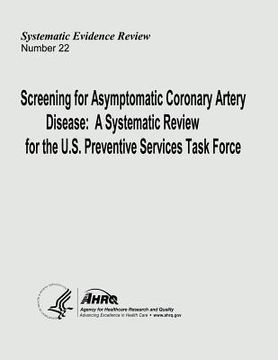Screening for Asymptomatic Coronary Artery Disease: A Systematic Review for the U.S. Preventive Services Task Force: Systematic Evidence Review Number (in English)
Synopsis "Screening for Asymptomatic Coronary Artery Disease: A Systematic Review for the U.S. Preventive Services Task Force: Systematic Evidence Review Number (in English)"
Coronary heart disease (CHD) is the leading cause of death in the United States. Each year, more than 1 million Americans experience nonfatal or fatal myocardial infarction or sudden death from CHD. The estimated direct and indirect costs of CHD and stroke were $298.2 billion for 2001. Angina is the most common presenting symptom of CHD, but in many persons the first manifestation may be myocardial infarction or sudden death. An estimated 1 to 2 million middle-aged men have asymptomatic but physiologically significant coronary artery disease, which puts them at increased risk for CHD events. In 1996, the U.S. Preventive Services Task Force (USPSTF) considered the use of resting electrocardiography (ECG) or exercise electrocardiography treadmill testing (ETT) to detect asymptomatic coronary artery disease (ACAD). The Task Force found insufficient evidence to recommend for or against screening middle-aged and older men and women with these tests. They recommended against screening children, adolescents, or young adults. Clinicians can use two approaches for preventing CHD morbidity and mortality. The first approach involves screening for, and treating, the traditional modifiable CHD risk factors, such as hypertension, abnormal blood lipids, diabetes, cigarette smoking, physical inactivity, and diet. Such an approach may incorporate explicit calculations of the patient's risk of CHD events, using risk prediction equations derived from the Framingham Study or other cohort studies. The second strategy involves supplementing risk factor-based screening with additional tests to provide further information about CHD risk. Some of these tests detect asymptomatic blockage of the coronary arteries, also known as ACAD; others provide indirect information about CHD risk. In this strategy, detection of ACAD or increased CHD risk would lead to additional use of risk-reducing treatments. Some of these treatments are directed at traditional risk factors (e.g., statins for hyperlipidemia); others are not (e.g., aspirin). Another potential rationale for screening for ACAD is to detect and treat (by bypass surgery or percutaneous coronary intervention) important blockages of the coronary arteries. Little information, however, is available to determine if such treatment is effective in asymptomatic populations. The best measure of the value of tests to identify ACAD or increased CHD risk would come from studies that examined whether patients randomized to receive such tests had fewer CHD events than patients randomized to receive standard risk factor assessment-guided treatment. Because no such evidence is available, we used observational cohort studies to examine whether these screening tests either lead to greater use of effective risk-reducing treatments or provide independent prognostic information about the risk of future CHD events. Such an assessment is based on each test.s ability to provide better information than would be obtained by the standard history, physical examination, and measurement of traditional risk factors and calculation of CHD risk using global CHD risk equations. In addition to information about benefits, we also searched for any information about harms of screening, including the likelihood of false-positive screening results and the effect of labeling an individual as being "high risk."

